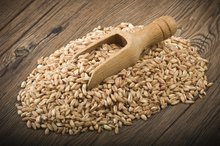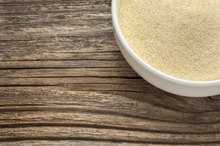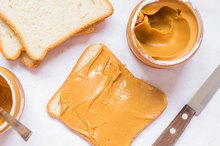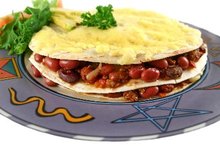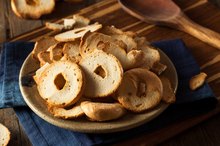Banana Bread Nutrition
Banana bread is typically made from flour, sugar, bananas, spices, baking powder and butter, margarine or oil. Unless you make it with whole wheat flour or add walnuts, banana bread provides calories but very few essential nutrients. Therefore, it is best to eat banana bread as a small side dish or dessert and not use it to replace breakfast or healthy snacks. Unless otherwise specified, values listed are for banana bread without walnuts.
Calories and Protein
One slice, or about 60 g, of banana bread without walnuts contains 196 calories, which come primarily from fat and carbohydrates. Banana bread contains only 2.6 g of protein, which provide only 10 of the 196 calories. The recommended amount, also called dietary reference intake or DRI, for protein per day is 46 g for women and 56 g for men. One slice of banana bread supplies less than 10 percent of this amount. However, eating one slice of banana bread with two scrambled eggs for breakfast would make a meal with close to 15 g of protein, which would supply over 25 percent of the DRI.
Carbohydrates
Nutrition Facts for Deep-Fried Bananas
Learn More
The majority of the calories, more than 120, in banana bread come from carbohydrates. There are three types of carbohydrates: sugar, starch and fiber. The majority of the carbohydrates in banana bread are sugar and starch, as one slice contains only .7 g of fiber. This is less than 5 percent of the DRI for fiber, which is found in foods such as fruits, vegetables, beans and whole grains. Baking banana bread with whole wheat flour instead of white flour would increase the fiber content, as would the addition of walnuts.
Fat
The rest of the calories in banana bread come from the 6.3 g of fat in each slice. If you make your bread with margarine, 1.3 g of this fat is saturated fat, which you should consume in limited quantities as it can lead to high cholesterol. However, margarine also contains trans fats, which can lead to high cholesterol, heart disease and diabetes. Using a heart-healthy oil instead of margarine would reduce the saturated fat content to under 1 g and would also reduce the cholesterol content from 26 mg to 0 mg.
Sodium
Nutrition Information for Turkey Lunch Meat
Learn More
Because salt is added to most baked goods to enhance other flavors, they usually contain moderate amounts of sodium, and banana bread is no exception. The American Heart Association recommends that you consume less than 1,500 mg of sodium per day to reduce your risk of heart disease. One slice of banana bread contains 181 mg, which is 12 percent of this amount.
Vitamins and Minerals
Although banana bread contains real bananas, which are high in vitamins and minerals, it does not provide large amounts of many of these nutrients. One slice supplies less than 10 percent of the DRI for all vitamins and minerals except selenium. One slice of banana bread provides 13 percent of the DRI for selenium, a mineral that acts as an antioxidant, supports the thyroid and boosts the immune system. Adding one cup of walnuts to a loaf of banana bread would increase the amount of many vitamins and minerals, especially copper, manganese and B-6. With walnuts, one slice of bread would provide more than 20 percent of the DRI for copper and manganese and 13 percent of the DRI for B-6.
Related Articles
References
Writer Bio
Lisa Thompson has been writing since 2008, when she began writing for the Prevention website. She is a holistic health practitioner, nationally certified massage therapist and National Council on Strength and Fitness-certified personal trainer. Thompson also holds certificates in nutrition and herbology from the Natural Healing Institute, as well as a Master of Education from California State University.


